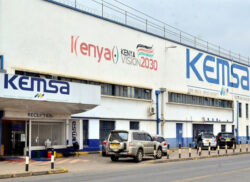
The Kenya Medical Supplies Authority (KEMSA) is a State corporation established through the Kenya Medical Supplies Authority Act No. 20 of 2013, leading to a change of name from an Agency to an Authority. The Authority’s functions, as outlined in the KEMSA Act that established it, are as follows:
- Procure, warehouse and distribute drugs and medical supplies for prescribed public health programmes, the national strategic stock reserve, prescribed essential health packages and national referral hospitals;
- Establish a network of storage, packaging and distribution facilities for the provision of drugs and medical supplies to health institutions;
- Enter into partnership with, or establish frameworks with, County Governments for purposes of providing services in procurement, warehousing, distribution of drugs and medical supplies;
- Collect information and provide regular reports to the National and County Governments on the status and cost-effectiveness of procurement, the distribution and value of prescribed essential medical supplies delivered to health facilities, stock status and on any other aspect of the supply system status and performance which may be required by stakeholders; and,
- Support County Governments to establish and maintain appropriate supply chain systems for drugs and medical supplies.
The transition from a Public Agency to a Public Authority was intended to give the Authority greater independence in decision-making and more financial autonomy to enable it effectively deliver on its expanded mandate in a devolved health system. Another reason for the transition from an Agency to an Authority was to move from a highly bureaucratic system of medical logistics to one that is competitive and customer focused.
Prior to the establishment of the Authority, the State corporation was referred to as the Kenya Medical Supplies Agency (KEMSA), having been established under the State Corporations Act through legal notice No. 17 of 2000, Cap 466 of the Laws of Kenya. This legal notice was repealed in 2013 to pave way for the KEMSA Act that established the Authority. The Kenya Medical Supplies Agency’s (KEMSA) functions were:
- Procure drugs and medical supplies, offer for sale and supply the same to public health institutions on such terms as the Board may from time to time prescribe;
- Establish warehouse facilities in Nairobi or any other towns of Kenya for the purposes of storage, packaging or sale of drugs and medical supplies to health institutions;
- Carry out or cause to be carried out technical and/or laboratory analysis of drugs and medical supplies to determine their suitability for procurement, sale, use, storage or disposal by the Agency;
- Advise the consumers and health providers on the rational and cost-effective use of drugs and medical supplies in consultation with other agencies;
- Use guidelines on the procurement, storage, use and disposal of pharmaceutical products within public health institutions in consultation with other agencies;
- Sub-contract any of the above functions to competent agents or institutions as may be determined by the Board, without prejudice to the objects for which the Agency is established; and
- Make available to facilities for use for educational purposes on such terms and conditions as the Board may deem necessary.
Before the Kenya Medical Supplies Agency was established, the medical supplies function was under the Ministry of Health’s Medical Supplies Coordination Unit (MSCU) – a government bureaucratic outfit that struggled to deliver on its mandate. Around 1996, the Ministry of Health set up an MSCU Working Group whose purpose was to reform and restructure the MSCU. Two years later, a Ministry of Health stakeholders’ committee met and recommended the establishment of a corporate entity to plan, procure, warehouse and distribute drugs and other medical supplies to public health facilities. KEMSA was created with the aim of bringing about radical improvements that MSCU was unable to achieve. Since inception in 2000, the Agency faced challenges that made it difficult to deliver on its mandate such as; inadequate funding from the Ministry of Health (MOH), lack of timely disbursement of procurement and operational budgets, lack of transparency and accountability, poor performance and lack of leadership and governance structure.
The history of medical stores in Kenya dates back to British rule (1915), when the Medical Stores was established. In 1927, the name was changed to Medical Stores and Equipment. After independence, the Ministry of Health was created, and the Kenya Medical Stores and Equipment was mainstreamed into it. In 1970, the government changed the name Medical Stores and Equipment to Central Medical Stores (CMS), and it was reorganised to improve control and accountability in medical supplies. The reorganisation led to the development of the Central Medical Store Management Information System (CMS/MIS) where more flexible, modifiable and integrated systems – including control of orders entry, inventory, sales analysis, financial management and accounts receivable and accounts payable – were integrated.
